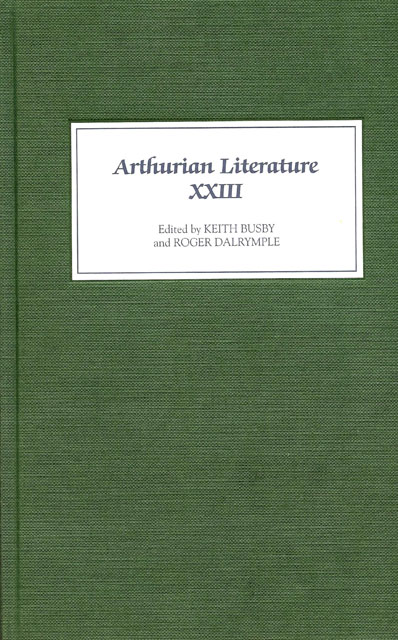Book contents
- Frontmatter
- Contents
- General Editor’s Foreword
- I Beyond Shame: Chivalric Cowardice and Arthurian Narrative
- II Malory’s Forty Knights
- III Fooling with Language: Sir Dinadan in Malory’s Morte Darthur
- IV William Caxton, Wynkyn de Worde and the Editing of Malory’s Morte Darthur
- V Ballad and Popular Romance in the Percy Folio
- VI Local Hero: Gawain and the Politics of Arthurianism
- VII Promise-postponement Device in The Awntyrs Off Arthure: a Possible Narrative Model
- VIII L’Atre perilleux and the Erasure of Identity
- IX The Theme of the Handsome Coward in the Post-Vulgate Queste del Saint Graal
- X A Time of Gifts? Jean de Nesle, William A. Nitze and The Perlesvaus
- XI Thomas Love Peacock’s The Misfortunes of Elphin and the Romantic Arthur
- Contents of Previous Volumes
V - Ballad and Popular Romance in the Percy Folio
Published online by Cambridge University Press: 23 March 2023
- Frontmatter
- Contents
- General Editor’s Foreword
- I Beyond Shame: Chivalric Cowardice and Arthurian Narrative
- II Malory’s Forty Knights
- III Fooling with Language: Sir Dinadan in Malory’s Morte Darthur
- IV William Caxton, Wynkyn de Worde and the Editing of Malory’s Morte Darthur
- V Ballad and Popular Romance in the Percy Folio
- VI Local Hero: Gawain and the Politics of Arthurianism
- VII Promise-postponement Device in The Awntyrs Off Arthure: a Possible Narrative Model
- VIII L’Atre perilleux and the Erasure of Identity
- IX The Theme of the Handsome Coward in the Post-Vulgate Queste del Saint Graal
- X A Time of Gifts? Jean de Nesle, William A. Nitze and The Perlesvaus
- XI Thomas Love Peacock’s The Misfortunes of Elphin and the Romantic Arthur
- Contents of Previous Volumes
Summary
Medieval English popular romance has received increasing attention from academics in recent years, especially with the publication of a number of edited volumes: W. R. J. Barron's Arthur of the English in 1999, followed by Ad Putter's and Jane Gilbert's Spirit of Medieval English Popular Romance in 2000 and Nicola McDonald's Pulp Fictions of Medieval England in 2004. These group projects display the growth in critical interest in popular romance, an area that editors and contributors to these collections alike deplore as insufficiently explored or sometimes neglected altogether by modern scholarship. As a step towards opening up the debate regarding the future of critical engagement with less immediately appealing medieval texts, this essay proposes to extend the discussion about popular romance by including the complex relationship between popular romance and the ballad. It will also address the problematic nature of cultural cross-fertilisation between these two (previously considered distinct) genres, and will interrogate the classifications adopted by critics to date. A related boundary, though one by no means easy to ascertain and always likely to spark off debate, is that between the target audiences for romances and ballads respectively, a starting point for future research, especially in the context of modern approaches to popular culture.
The editors of the above collections have each summarised the debate over the usefulness of studying medieval popular romance, often stressing the detrimental effect of its reception among modern readerships through critical approaches to this genre. As a result most critics choose not to tackle what is perceived as a debased version of a more sophisticated traditional romance, but instead turn to more ‘serious issues’, like ‘manuscripts, editorial issues, textual history’, which are significantly more valued in terms of academic output. In her provocative ‘Polemical introduction’ to Pulp Fictions, McDonald deals with literary assessments of the popular romance, and goes even further in denouncing modern tendencies to discard the study of such texts; she suggests that there is a ‘thinly – if at all – veiled repugnance to the romances themselves, not only to the poetic form, but their subject matter and the medieval audience who is imagined to enjoy them’.
- Type
- Chapter
- Information
- Arthurian Literature XXIII , pp. 68 - 80Publisher: Boydell & BrewerPrint publication year: 2006

